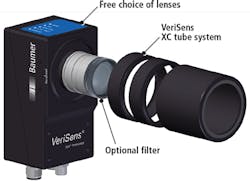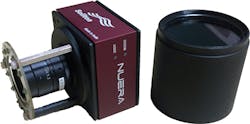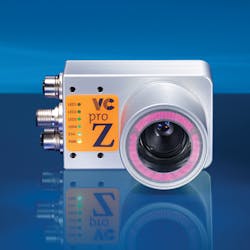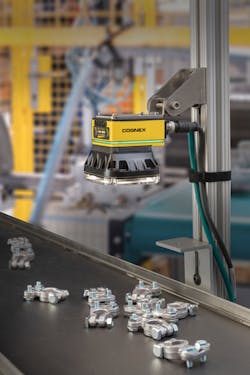Camera Design: Modular lens and lighting components boost smart camera flexibility
Smart cameras can now perform machine vision applications ranging from barcode reading and presence/absence detection to glue-bead inspection, optical character reading and package inspection. Whether the device is called an image-based barcode reader, a vision sensor or a smart camera, such products typically include at least an image sensor coupled with on-board processing and I/O capability.
Smart camera popularity is on the rise because such devices can save development time and money, especially in machine vision applications that can be precisely defined. Instead of having to specify the individual camera, frame grabber, PC, and software components often associated with machine vision system design, developers can simplify deployment by leveraging integrated lighting, lenses, and processors, and focusing mainly on the software development required to perform a particular task.
Having said that, such all-in-one solutions that are shipped pre-built with integrated optics and illumination may offer limited flexibility, especially if application requirements change between the evaluation, integration and testing phases of the project. For example, production parts may differ from the pre-production components that were used for the evaluation and quote. Surface finish on machined metal parts may appear different from various vendors. Material handling or fixed tooling may require changes to the camera or light position. Product designs may change after the budget and ROI are calculated, or new product variations may be added to the manufacturing mix after the smart cameras are installed.
Baumer's VeriSens XC series smart cameras provides C-mount
lens flexibility and a modular tube system to maintain
IP67 protection with various size lenses.
Because of these integration challenges, several smart camera vendors have come up with novel semi-modular designs that increase application flexibility by allowing users the ability to swap out lights, filters and optics in the field while maintaining IP ratings to help ease integration problems as they arise, reduce total cost of ownership, and increase application flexibility.
While C-mount threads on smart cameras make it very easy to change lenses, shelving previously purchased, unused lenses can add to the cost and time required to deploy the solution. However, in space-constrained applications, it's important to be sure the new lens will fit in the space the camera is mounted, or inside the IP67 enclosure, if one is specified.
The VeriSens XC series smart cameras from Baumer (Radeberg, Germany;www.baumer.com), for example, provides C-mount flexibility for lensing options and a modular tube system to maintain IP67 protection. Additionally, this design allows the use of various filters such as polarization and a choice of environmental protection between IP67 and IP69k.
C-mount and S-mount lens adaptors and a ring-shaped PCB
with mounted LEDs in various colors that can be accessed and
swapped out by the user, along with filters of different wavelengths.
Further optic flexibility can be achieved by offering C-mount and S-mount lens adaptors such as those found on the NUERA modular smart camera from Soliton Technologies (Bangalore, India;www.solitontech.com). The design also integrates a ring-shaped PCB with mounted LEDs for illumination, which can be accessed by removing the lens casing allowing LED PCBs of various colors to be swapped out by the user. The UV filter is also easily replaced with other filters of different wavelengths.
Likewise, the VC pro Z series from Vision Components (Ettlingen, Germany;www.vision-components.com) offers C-mount and S-mount lens threads and lens covers in several lengths to maintain IP67 protection for different size lenses. The system can be equipped with IR, UV, white, blue or red LED ring lights, and lens covers are available with or without a light diffuser to tailor the illumination for specific applications.
Not to be outdone, Cognex (Natick, MA, USA;www.cognex.com) offers the In-Sight 7802, which also supports a variety of C-mount, S-mount and even autofocus lenses, as well as interchangeable light rings within an IP67 enclosure. If the lighting requirements change, users can switch between white, red, blue or IR LED boards, with optional diffuse, polarized and clear front covers that also allow for a variety of internal filters of different wavelengths. Moreover, the unique lighting system is designed to work from a few inches away to more than three feet away. Plus, the lights have four, independently-controllable banks that allow on-the-spot lighting changes to optimize part illumination.
The VC pro Z series from Vision Components offers C-mount and
S-mount lens flexibility and lens covers in several lengths to maintain
IP67 protection for different size lenses. Lens covers are available
with or without a light diffuser and IR, UV, white or red LED
ring lights are available.
Adding even more functionality to the optical system without adding a lot of additional cost is an integrated electrical connection to control field-changeable autofocus optics when using S-mount lenses. An S-mount autofocus system has two main benefits. First, it can simplify initial camera setup when it may be difficult to reach the lens. It can also save money, time and resources required to maintain repeatability during production changeovers by automatically adapting to different part sizes and eliminating the need to physically move the camera or manually adjust the focus position.
No single light design can solve every machine vision application or adapt to modifications that occur during deployment. However, when integrated illumination is not sufficient for an application, each of these modular smart camera designs also provide a direct connection to power and control external lights, allowing users to select between continuous or strobe operation for auxiliary bar, ring, or back lights within the configuration software without adding additional light-control hardware or software.
and even autofocus lenses and interchangeable light rings within an
IP67 enclosure. A unique lighting system is designed to work from
a few inches away to over three feet away and offers four,
independently-controllable banks to allow on-the-spot
changes to optimize part illumination.
Though modular optics and lighting will not be able to address every deployment scenario, the trend towards IP67, field changeable optics and illumination will certainly offer smart camera users benefits in terms of expandability, future-proofing, customization, cost savings and reparability.




